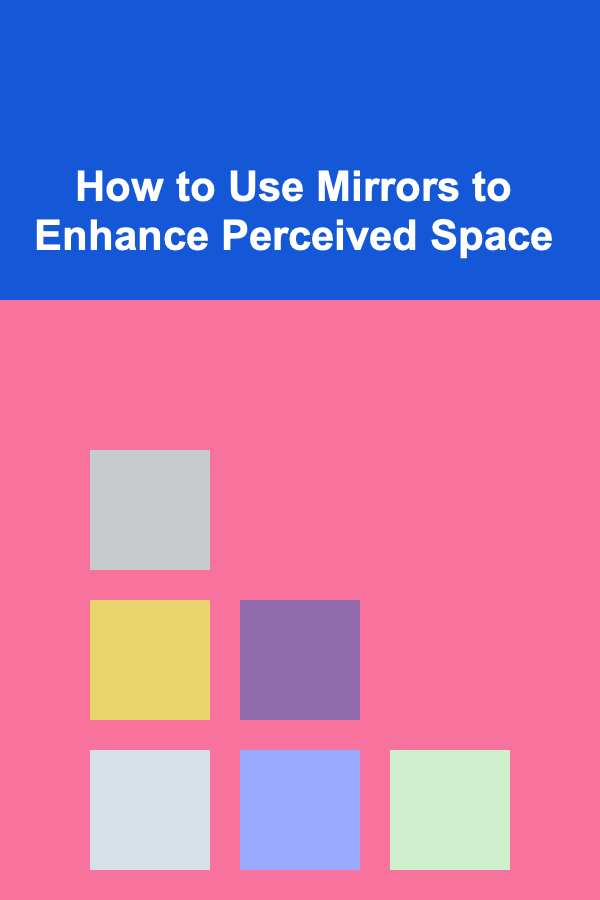
How to Use Mirrors to Enhance Perceived Space
ebook include PDF & Audio bundle (Micro Guide)
$12.99$5.99
Limited Time Offer! Order within the next:

Mirrors are powerful design tools that can dramatically alter the perception of space within any room. When strategically used, mirrors can create an illusion of depth, enhance natural light, and add a touch of elegance to your décor. This comprehensive guide will explore various ways to utilize mirrors effectively in your home, offering insights into their placement, styles, and benefits for enhancing perceived space.
Understanding the Role of Mirrors in Interior Design
1. Illusion of Space
Mirrors have long been recognized for their ability to create the illusion of more space. By reflecting light and images, they can make small areas feel larger and more open.
2. Light Enhancement
Mirrors can amplify natural light by reflecting it throughout the room. This effect is particularly beneficial in dimly lit spaces where additional illumination is needed.
3. Aesthetic Appeal
Apart from their functional benefits, mirrors add an element of beauty to your interior design. They come in various shapes, sizes, and styles, serving as decorative elements that enhance the overall aesthetic.
4. Focal Points
Large or uniquely designed mirrors can serve as focal points in a room, drawing attention and anchoring the space. They can be used to create visual interest and balance.
Understanding the multifaceted roles that mirrors can play in interior design sets the stage for effective utilization in enhancing perceived space.
The Psychology of Space Perception
1. Visual Depth
The human brain perceives depth through visual cues. Mirrors provide additional surface area for reflection, contributing to the perception of depth in a flat environment.
2. Spaciousness and Comfort
Research indicates that people feel more comfortable and relaxed in spaces that appear larger. Using mirrors effectively can foster feelings of openness and tranquility.
3. Reflecting Surroundings
Mirrors reflect not just light but also colors and patterns. This reflects the surrounding environment, creating continuity and harmony within the space.
Fostering an understanding of how we perceive space psychologically allows you to use mirrors thoughtfully to enhance comfort and spaciousness.
Choosing the Right Mirrors
The selection of mirrors plays a crucial role in achieving the desired effects:
1. Size Matters
- Large Mirrors: These are great for creating a dramatic impact and amplifying space. They work well in living rooms, bedrooms, and entryways.
- Small Mirrors: Smaller mirrors can be used in clusters to create interest and reflect light without overwhelming a space.
2. Shape Selection
- Rectangular Mirrors: Ideal for narrow spaces, they can elongate walls and create a sleek look.
- Round Mirrors: These soften corners and create a sense of flow, often used in casual or bohemian designs.
- Abstract Shapes: Unique designs can become statement pieces, adding character to the decor.
3. Frame Style
- Frameless: Offers a minimalist look, making them versatile for various interiors.
- Ornate Frames: Can add a vintage or eclectic touch, perfect for traditional or bohemian styles.
- Industrial Frames: Metal frames work well in modern or industrial-themed spaces.
Choosing mirrors that align with your design style and the intended effect is foundational for enhancing perceived space.
Placement Strategies for Maximum Impact
Strategic placement is essential to maximize the benefits of mirrors:
1. Opposite Windows
Place mirrors directly across from windows to reflect natural light and brighten up dark areas. This trick helps in making a room feel airy and open.
2. In Small Rooms
Utilize mirrors on walls in small rooms, such as bathrooms or closets, to visually expand the space. Consider placing them behind doors or on the walls adjacent to furniture.
3. Above Furniture
Hanging mirrors above furniture, like sofas or consoles, creates a layered effect that adds depth. Ensure that the center of the mirror is at eye level for optimal viewing.
4. Hallways and Entryways
Use mirrors in hallways to create a feeling of length and brightness. In entryways, they can help guests quickly check their appearance while also enhancing the overall ambiance.
5. Corner Placement
Positioning mirrors in corners can help bounce light around the room, enhancing the perception of space. This is especially effective in tight areas.
Implementing these placement strategies ensures that mirrors contribute positively to the overall spatial experience in your home.
Types of Mirrors and Their Effects
Different types of mirrors yield varying effects on the perception of space:
1. Full-Length Mirrors
These mirrors are ideal for personal use and can make a room feel taller. They work wonderfully in bedrooms and dressing areas, reflecting both light and the surroundings.
2. Wall Mirrors
Wall-mounted mirrors can be used to create focal points. They are adaptable for various uses and spaces, whether large or small.
3. Decorative Mirrors
Mirrors with artistic designs can act as standalone pieces. These can serve as wall art while also providing reflective qualities.
4. Mirrored Furniture
Consider incorporating mirrored furniture, such as coffee tables or cabinets. These pieces add glamour and sophistication while maintaining functionality.
Identifying the types of mirrors that best suit your needs allows you to take full advantage of their effects on perceived space.
Creative Ideas for Mirror Use
Get inspired with these creative ideas to implement mirrors throughout your home:
1. Gallery Walls
Create a gallery wall using a mix of artworks and mirrors. Arrange different shapes and sizes to add dynamic elements to your décor.
2. Layered Reflections
Position multiple mirrors at varying heights to create layered reflections. This technique captures light from different angles, enhancing brightness.
3. Mirror Frames as Art
Decorate plain mirrors with unique frames or DIY additions. Use materials like twine, mosaic tiles, or paint to turn your mirrors into captivating art pieces.
4. Outdoor Spaces
Incorporate weather-resistant mirrors in outdoor areas to enhance garden views and provide a sense of expansion.
5. Reflective Accents
Incorporate smaller mirrors into decorative accessories, such as trays or wall sconces, to subtly enhance light and space without overwhelming the decor.
Using mirrors creatively allows you to innovate while achieving the desired effect of expanding perceived space.
Cleaning and Maintaining Your Mirrors
Clean, well-maintained mirrors ensure optimal performance and appearance:
1. Regular Cleaning
Dust mirrors regularly to prevent buildup. Use a microfiber cloth for gentle cleaning, ensuring no scratches occur.
2. Use Glass Cleaner
For deeper cleanings, opt for a glass cleaner free from ammonia to avoid streaks. Spray the cleaner onto the cloth rather than directly onto the mirror to prevent drips.
3. Handle with Care
When moving or hanging mirrors, always handle them carefully to avoid cracks or breaks. Seek assistance when dealing with larger mirrors.
Maintaining your mirrors with care ensures they continue to enhance your space effectively.
Common Mistakes to Avoid
To maximize the benefits of mirrors in your home, avoid these common mistakes:
1. Overloading with Mirrors
While mirrors are useful, overdoing it can lead to chaos. Aim for balance; too many mirrors can overwhelm a space instead of enhancing it.
2. Poor Placement
Avoid placing mirrors in locations that do not reflect appealing views or natural light. Always consider what's being reflected to maintain aesthetics.
3. Neglecting Size Proportions
Ensure that the size of the mirror aligns with the scale of the room and the furniture. Oversized mirrors can dwarf a space, while tiny mirrors can get lost.
4. Ignoring Lighting
Failing to consider lighting conditions can diminish the effectiveness of mirrors. Keep natural light in mind when choosing mirror placements.
Being aware of these pitfalls will help you use mirrors more effectively in your decorative strategy.
Conclusion
Mirrors are invaluable tools in interior design, capable of transforming small spaces into expansive, inviting environments. By understanding their roles, selecting appropriate styles, and employing strategic placement, you can enhance the perceived space within your home significantly.
Whether adding light, creating depth, or beautifying your décor, mirrors offer endless possibilities for creativity and function. Embrace the power of mirrors in your design strategy, and watch as they elevate your living space, making it feel larger and more welcoming. With thoughtful curation and maintenance, mirrors can remain a shining feature in your home for years to come.

How to Create a Checklist for Enhancing Your Skin Health
Read More
How to Diversify Your Investment Portfolio for Maximum Growth
Read More
How to Host a Family Book Club with Age-Appropriate Reads
Read More
How to Make Your One-Page Website Stand Out with Animation and Interaction
Read More
How to Minimize Noise from Outside with Effective Soundproofing
Read More
How to Mix Vintage and Modern Decor on a Budget
Read MoreOther Products

How to Create a Checklist for Enhancing Your Skin Health
Read More
How to Diversify Your Investment Portfolio for Maximum Growth
Read More
How to Host a Family Book Club with Age-Appropriate Reads
Read More
How to Make Your One-Page Website Stand Out with Animation and Interaction
Read More
How to Minimize Noise from Outside with Effective Soundproofing
Read More